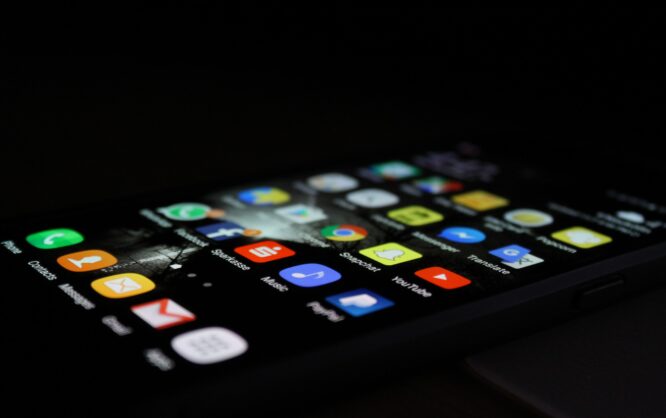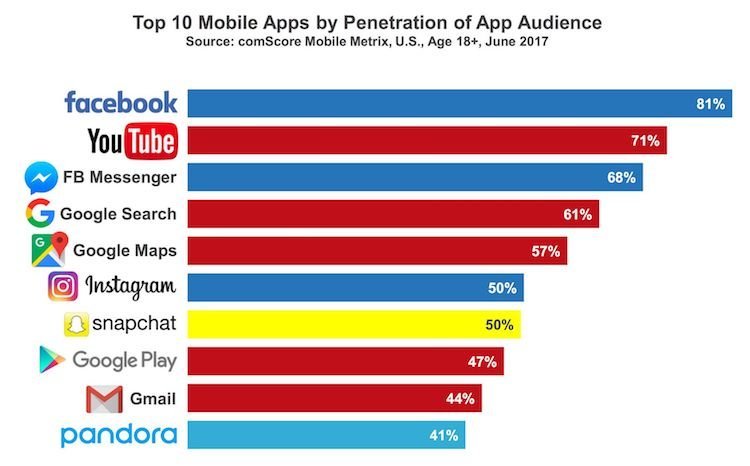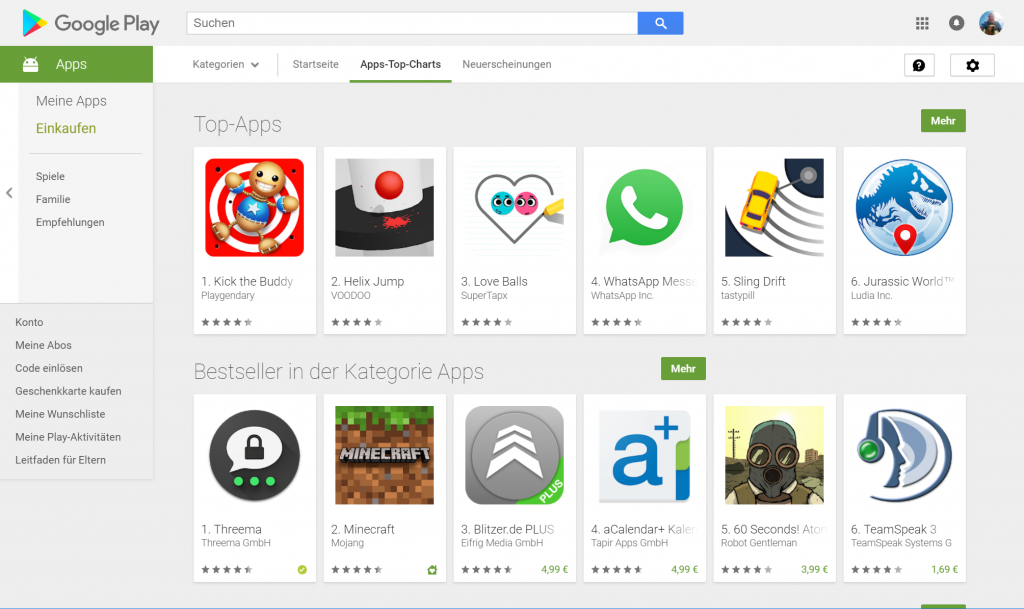Designer, Don’t Create Apps When Websites Suffice

With that many smartphones around, you definitely need an app. This is what many inexperienced people, also known as clients, think. However, even some experts recommend using native apps for redesigns, rather than a website. This article explains why that's wrong.
Let's first define the terms. When speaking of websites and apps, we mean a presence accessible on the web, and the native app as we know it from the world's app stores. A web app, in that sense, would be a website with expanded functionalities.
 Source: comScore[/caption]
Here, it makes sense to take the Facebook app out of consideration, as it is nothing but an appified form of web usage. Facebook is by far the biggest digital presence of the planet. This can't be considered a reference. The same goes for YouTube. Here, using the mobile site comes with no advantages. The app accesses the same content.
Noteworthy: eight of the ten most used apps either belong to Facebook or Google. Does your client have a chance to compete? The statistics are meant to be read like this, by the way: 81 percent of smartphone users use the Facebook app, and so forth.
Let's use eMarketer to look at the usage areas of mobile app users. Most of them are mostly irrelevant on the stationary computer. The main reason for this being the very specific orientation of mobile apps towards mobile devices. Of course, I'd rather play a little game on my smartphone. After all, it has sensors to make playing more interesting, and I have it on me at all times. Of course, I'd rather use productivity apps like task managers, calendars, and so on on my smartphone, as they're always accessible that way. Small utilities have only created their share via the availability of smartphones.
The gaming section has a solid share of 14,3 percent. However, they stand no chance against social networks and their share of 23,9 percent. Mobile video apps have a share of 18,7 percent. The number wasn't on previous lists. Musically and Co have created a real boom. All of these application cases share the fact that they are destined for mobile devices.
To wrap this up, let's take a look at a screenshot of today's top apps in the Google Play Store:
[caption id="attachment_104802" align="aligncenter" width="1024"]
Source: comScore[/caption]
Here, it makes sense to take the Facebook app out of consideration, as it is nothing but an appified form of web usage. Facebook is by far the biggest digital presence of the planet. This can't be considered a reference. The same goes for YouTube. Here, using the mobile site comes with no advantages. The app accesses the same content.
Noteworthy: eight of the ten most used apps either belong to Facebook or Google. Does your client have a chance to compete? The statistics are meant to be read like this, by the way: 81 percent of smartphone users use the Facebook app, and so forth.
Let's use eMarketer to look at the usage areas of mobile app users. Most of them are mostly irrelevant on the stationary computer. The main reason for this being the very specific orientation of mobile apps towards mobile devices. Of course, I'd rather play a little game on my smartphone. After all, it has sensors to make playing more interesting, and I have it on me at all times. Of course, I'd rather use productivity apps like task managers, calendars, and so on on my smartphone, as they're always accessible that way. Small utilities have only created their share via the availability of smartphones.
The gaming section has a solid share of 14,3 percent. However, they stand no chance against social networks and their share of 23,9 percent. Mobile video apps have a share of 18,7 percent. The number wasn't on previous lists. Musically and Co have created a real boom. All of these application cases share the fact that they are destined for mobile devices.
To wrap this up, let's take a look at a screenshot of today's top apps in the Google Play Store:
[caption id="attachment_104802" align="aligncenter" width="1024"] No app version of a website in sight. (Screenshot. D. Petereit)[/caption]
What did you notice for both studies above, as well as the screenshot? Right, there is no large brand with an app that would cover the classic tasks of the existing website.
No app version of a website in sight. (Screenshot. D. Petereit)[/caption]
What did you notice for both studies above, as well as the screenshot? Right, there is no large brand with an app that would cover the classic tasks of the existing website.
People Spend More and More Time on Their Mobile Devices
There are tons of studies on the topic of native app usage, supporting different points of view. Oftentimes, this only depends on how we read the results. Let's take a look at the most striking examples. In the current US Mobile App Report for 2017, the statistics company Comscore released numbers on the time users spend on their mobile devies. It turns out that mobile users spend 87 percent of their time in apps, and only 13 percent using mobile browsers on the web. This number has remained consistent for years, though it has been declining for mobile browsers over the past two years. Well, this is a very obvious statement, is what your client may think. I need an app for my business. After all, this gives me a chance of 87:13 of me being noticed on mobile. This assumption is wrong. If we look at the top 10 apps, it becomes obvious that this is not a rivalry between the open web and the app cosmos. The users simply use their devices differently. [caption id="attachment_104804" align="aligncenter" width="750"] Source: comScore[/caption]
Here, it makes sense to take the Facebook app out of consideration, as it is nothing but an appified form of web usage. Facebook is by far the biggest digital presence of the planet. This can't be considered a reference. The same goes for YouTube. Here, using the mobile site comes with no advantages. The app accesses the same content.
Noteworthy: eight of the ten most used apps either belong to Facebook or Google. Does your client have a chance to compete? The statistics are meant to be read like this, by the way: 81 percent of smartphone users use the Facebook app, and so forth.
Let's use eMarketer to look at the usage areas of mobile app users. Most of them are mostly irrelevant on the stationary computer. The main reason for this being the very specific orientation of mobile apps towards mobile devices. Of course, I'd rather play a little game on my smartphone. After all, it has sensors to make playing more interesting, and I have it on me at all times. Of course, I'd rather use productivity apps like task managers, calendars, and so on on my smartphone, as they're always accessible that way. Small utilities have only created their share via the availability of smartphones.
The gaming section has a solid share of 14,3 percent. However, they stand no chance against social networks and their share of 23,9 percent. Mobile video apps have a share of 18,7 percent. The number wasn't on previous lists. Musically and Co have created a real boom. All of these application cases share the fact that they are destined for mobile devices.
To wrap this up, let's take a look at a screenshot of today's top apps in the Google Play Store:
[caption id="attachment_104802" align="aligncenter" width="1024"]
Source: comScore[/caption]
Here, it makes sense to take the Facebook app out of consideration, as it is nothing but an appified form of web usage. Facebook is by far the biggest digital presence of the planet. This can't be considered a reference. The same goes for YouTube. Here, using the mobile site comes with no advantages. The app accesses the same content.
Noteworthy: eight of the ten most used apps either belong to Facebook or Google. Does your client have a chance to compete? The statistics are meant to be read like this, by the way: 81 percent of smartphone users use the Facebook app, and so forth.
Let's use eMarketer to look at the usage areas of mobile app users. Most of them are mostly irrelevant on the stationary computer. The main reason for this being the very specific orientation of mobile apps towards mobile devices. Of course, I'd rather play a little game on my smartphone. After all, it has sensors to make playing more interesting, and I have it on me at all times. Of course, I'd rather use productivity apps like task managers, calendars, and so on on my smartphone, as they're always accessible that way. Small utilities have only created their share via the availability of smartphones.
The gaming section has a solid share of 14,3 percent. However, they stand no chance against social networks and their share of 23,9 percent. Mobile video apps have a share of 18,7 percent. The number wasn't on previous lists. Musically and Co have created a real boom. All of these application cases share the fact that they are destined for mobile devices.
To wrap this up, let's take a look at a screenshot of today's top apps in the Google Play Store:
[caption id="attachment_104802" align="aligncenter" width="1024"] No app version of a website in sight. (Screenshot. D. Petereit)[/caption]
What did you notice for both studies above, as well as the screenshot? Right, there is no large brand with an app that would cover the classic tasks of the existing website.
No app version of a website in sight. (Screenshot. D. Petereit)[/caption]
What did you notice for both studies above, as well as the screenshot? Right, there is no large brand with an app that would cover the classic tasks of the existing website.

Hi Dieter
Very nice and useful information thanks For Share
Write awesome. I’m a client access on your website page and you wish to over your website to the absolute website. I’m will be a regular access through one in long time.
Wow, wonderful post thanks For Share with us very helpful post.
Great post! I would love to share it on my network.
Yes, the article is correctly written. But many sites are progressing over time and things can change. For example, for instagram there are more and more various applications for attracting subscribers, such as ingramer.com and many others. This applies not only instagram, but many others. I think if every creator of his site will move forward, then everything is possible.